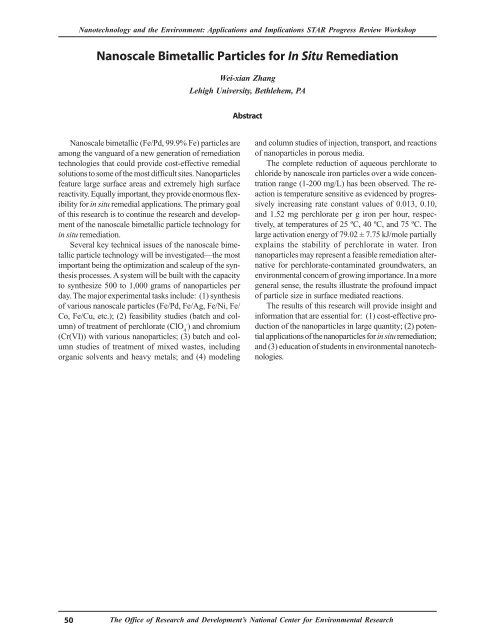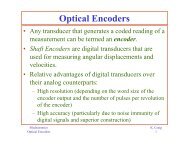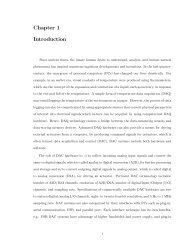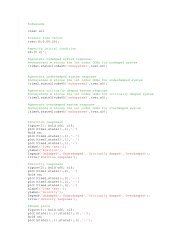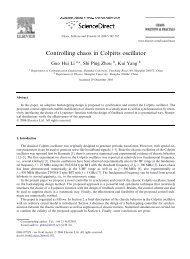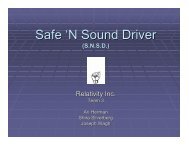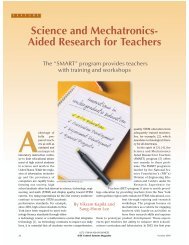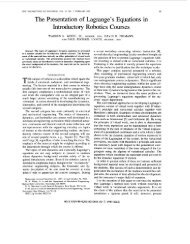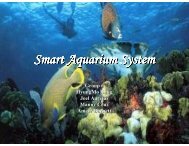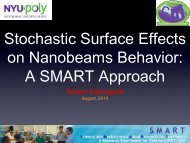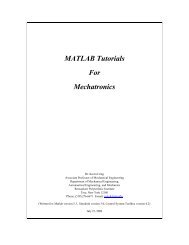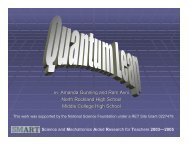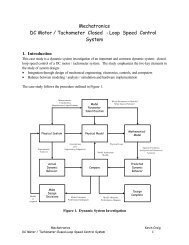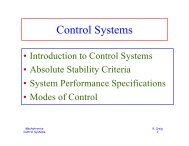EPA Nanotechnology and the Environment ... - Mechatronics
EPA Nanotechnology and the Environment ... - Mechatronics
EPA Nanotechnology and the Environment ... - Mechatronics
You also want an ePaper? Increase the reach of your titles
YUMPU automatically turns print PDFs into web optimized ePapers that Google loves.
<strong>Nanotechnology</strong> <strong>and</strong> <strong>the</strong> <strong>Environment</strong>: Applications <strong>and</strong> Implications STAR Progress Review Workshop<br />
Nanoscale Bimetallic Particles for In Situ Remediation<br />
Wei-xian Zhang<br />
Lehigh University, Bethlehem, PA<br />
Abstract<br />
Nanoscale bimetallic (Fe/Pd, 99.9% Fe) particles are<br />
among <strong>the</strong> vanguard of a new generation of remediation<br />
technologies that could provide cost-effective remedial<br />
solutions to some of <strong>the</strong> most difficult sites. Nanoparticles<br />
feature large surface areas <strong>and</strong> extremely high surface<br />
reactivity. Equally important, <strong>the</strong>y provide enormous flexibility<br />
for in situ remedial applications. The primary goal<br />
of this research is to continue <strong>the</strong> research <strong>and</strong> development<br />
of <strong>the</strong> nanoscale bimetallic particle technology for<br />
in situ remediation.<br />
Several key technical issues of <strong>the</strong> nanoscale bimetallic<br />
particle technology will be investigated—<strong>the</strong> most<br />
important being <strong>the</strong> optimization <strong>and</strong> scaleup of <strong>the</strong> syn<strong>the</strong>sis<br />
processes. A system will be built with <strong>the</strong> capacity<br />
to syn<strong>the</strong>size 500 to 1,000 grams of nanoparticles per<br />
day. The major experimental tasks include: (1) syn<strong>the</strong>sis<br />
of various nanoscale particles (Fe/Pd, Fe/Ag, Fe/Ni, Fe/<br />
Co, Fe/Cu, etc.); (2) feasibility studies (batch <strong>and</strong> column)<br />
of treatment of perchlorate (ClO 4-<br />
) <strong>and</strong> chromium<br />
(Cr(VI)) with various nanoparticles; (3) batch <strong>and</strong> column<br />
studies of treatment of mixed wastes, including<br />
organic solvents <strong>and</strong> heavy metals; <strong>and</strong> (4) modeling<br />
<strong>and</strong> column studies of injection, transport, <strong>and</strong> reactions<br />
of nanoparticles in porous media.<br />
The complete reduction of aqueous perchlorate to<br />
chloride by nanoscale iron particles over a wide concentration<br />
range (1-200 mg/L) has been observed. The reaction<br />
is temperature sensitive as evidenced by progressively<br />
increasing rate constant values of 0.013, 0.10,<br />
<strong>and</strong> 1.52 mg perchlorate per g iron per hour, respectively,<br />
at temperatures of 25 ºC, 40 ºC, <strong>and</strong> 75 ºC. The<br />
large activation energy of 79.02 ± 7.75 kJ/mole partially<br />
explains <strong>the</strong> stability of perchlorate in water. Iron<br />
nanoparticles may represent a feasible remediation alternative<br />
for perchlorate-contaminated groundwaters, an<br />
environmental concern of growing importance. In a more<br />
general sense, <strong>the</strong> results illustrate <strong>the</strong> profound impact<br />
of particle size in surface mediated reactions.<br />
The results of this research will provide insight <strong>and</strong><br />
information that are essential for: (1) cost-effective production<br />
of <strong>the</strong> nanoparticles in large quantity; (2) potential<br />
applications of <strong>the</strong> nanoparticles for in situ remediation;<br />
<strong>and</strong> (3) education of students in environmental nanotechnologies.<br />
50<br />
The Office of Research <strong>and</strong> Development’s National Center for <strong>Environment</strong>al Research


